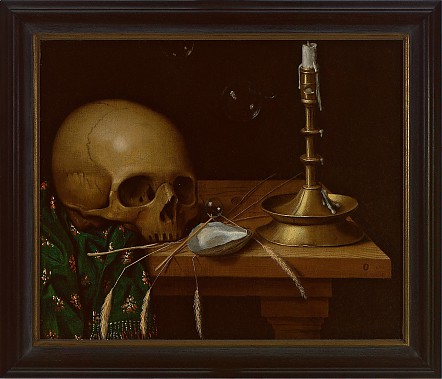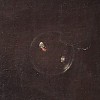Vanitas Still Life
Vanitas still life, Dutch, about 1700
Oil on canvas; 41 x 49,5 cm (without frame)
Foundation of the Sparkassen-Kulturstiftung
At all times many people were afraid of dying and death. But death itself was always something very fascinating because of its inevitability. Such an apparently contradictory attitude is reflected quite impressively in the vanitas still lifes of the 17th century, the heyday of that subject. Vanitas, Latin for vanity and transience, was intended to remind us that one cannot escape death and that dying is certain. This statement was better known as "Memento mori!" (Memento mori!). In order to have this thought always present, it was also transferred to everyday objects. The motif of the skull appeared particularly often. It was worked into objects of daily use, painted on or carved into them, so that it was often in front of our eyes and we became aware of its short earthly existence. Vanitas still lifes were certainly hung in one's own house. They were understood less as art than as a warning and reminder of one's own death.

Photo: Frank Hellwig
© Museum für Sepulkralkultur, Kassel, Bildarchiv




The Vanitas still life from the collection of the Museum of Sepulchral Culture depicts, among other exhibits, some other important symbols of the memento-mori thought. On a table stands an almost completely burnt out, extinguished candle. Next to it there is a shell filled with soapy water that symbolizes the passing prosperity. Also on the table are ears of corn. They may remind us of vitality, fertility and vitality, but by being bent, they in turn symbolize the inevitable death. Next to the skull, a few soap bubbles float. They illustrate the idea of transience particularly well, because they still shimmer in the light and reflect the colourful life - but they will soon burst. Other popular vanitas symbols in early modern art were fruit bowls and bouquets of flowers with first signs of decay, (sand) clocks symbolizing the passing of time, musical instruments whose tones vanished as quickly as they came - in this sense also sheet music -, overturned glasses, mirrors, dried bread loaves, books and so on. Occasionally these symbols were provided with captions. An example of this is the painting "Vanitasallegory" by Jacques de Gheyn II. (c. 1565-1629) with the line: "servare modum, finemque tueri, naturam sequi" (Keep the measure, consider the end and follow nature). The observer is admonished to enjoy life while observing Christian and ethical-moral values and not to forget his own transience. One is called upon to deal with death and to accept it as part of the eternal cycle and thus as something inevitable.
The 17th century was the heyday of the vanitas still life, which developed into a genre of its own. But even afterwards, various transient motifs can still be found on everyday objects and in art. Although the warning of the memento mori lost much of its importance at the beginning of the 19th century, it has not completely disappeared today, but can still be found occasionally on grave markers or in obituaries, as well as in art and film.
Julia Thomalla
Arbeitsgemeinschaft Friedhof und Denkmal e.V.
Zentralinstitut für Sepulkralkultur
Museum für Sepulkralkultur
Weinbergstraße 25–27
D-34117 Kassel | Germany
Tel. +49 (0)561 918 93-0
info@sepulkralmuseum.de








